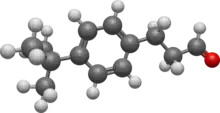Bourgeonal
Bourgeonal is an aromatic aldehyde used in perfumery. It has a fragrance reminiscent of lily of the valley, otherwise described as floral, watery, green and aldehydic. It is a pale yellow liquid at room temperature.
 | |
 | |
| Names | |
|---|---|
| Preferred IUPAC name
3-(4-tert-Butylphenyl)propanal | |
| Identifiers | |
3D model (JSmol) |
|
| ChemSpider | |
| ECHA InfoCard | 100.038.182 |
| EC Number |
|
PubChem CID |
|
| UNII | |
CompTox Dashboard (EPA) |
|
| |
| |
| Properties | |
| C13H18O | |
| Molar mass | 190.286 g·mol−1 |
| Appearance | Pale yellow liquid |
| Density | 0.938 g/cm3 |
| Boiling point | 265.1 °C (509.2 °F; 538.2 K) |
Except where otherwise noted, data are given for materials in their standard state (at 25 °C [77 °F], 100 kPa).
Infobox references | |
It is toxic if swallowed and can cause skin irritation and sensitisation on contact.
In a 2003 study it was found that in vitro, bourgeonal acts as a chemo-attractant for human spermatozoa, activating an olfactory receptor called OR1D2 (formerly called hOR17-4)[1] which opens calcium ion channels in the sperm, leading them to swim twice as fast.[2] Bourgeonal is suspected to be involved in helping sperm locate the ovum.
As of 2010, bourgeonal is the only known odor substance to which males have a higher average sensitivity than females.[1] This is thought to be because the same olfactory receptor (OR1D2) is expressed in non-olfactory tissue in sperm cells as well as the olfactory tissue of the nose. The involvement with sperm chemotaxis causes an evolutionary pressure for males (sexual selection) that causes them to have more OR1D2 receptors on average, both in the nose as well as in sperm.
References
- Peter Olsson and Matthias Laska (2010). "Human Male Superiority in Olfactory Sensitivity to the Sperm Attractant Odorant Bourgeonal". Chemical Senses. 35 (5): 427–32. doi:10.1093/chemse/bjq030. PMID 20378596.
- Spehr, M.; Gisselmann, G; Poplawski, A; Riffell, JA; Wetzel, CH; Zimmer, RK; Hatt, H (2003). "Identification of a Testicular Odorant Receptor Mediating Human Sperm Chemotaxis". Science. 299 (5615): 2054–58. doi:10.1126/science.1080376. PMID 12663925. S2CID 45306091.